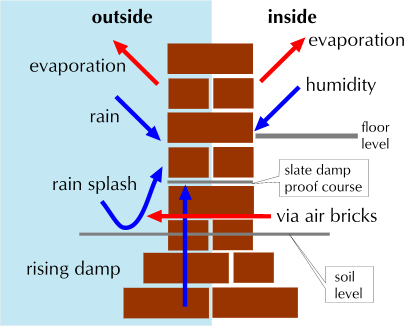
Managing Damp
Before you involve contractors to solve a damp problem, have a good look at your walls. It is only in recent decades that buildings have been built with damp-proof courses, yet there are mediaeval buildings which have stood for hundreds of years. You need to achieve a balance between water entering and leaving the walls:

Moisture enters the wall from three directions:
- from the soil upwards
- from rain
- from humidity inside the building - from bathing, washing and human bodies
Most houses of the period have a slate damp proof course. This prevents ground water passing further up the wall.
Moisture can travel through the wall through any porosity in the bricks, and along the mortar beds. So it can track through to internal walls.
Moisture leaves the wall by evaporation, either into the internal air or outside, and by the air flow through air bricks. Expect a saturated wall to dry at one month per inch of wall i.e. an eight inch wall will take eight months to dry out.
Our objective is therefore to manage this balance. We can do many things to improve it:
- where possible, use mortars and plasters made from lime rather than cement and/or gypsum. These lime mortars and plasters are vapour permeable and allow low levels of damp in walls to be removed by the process of evaporation.
- ventilate the rooms adequately to reduce the level of internal humidity and enable evaporation from the wall
- try to avoid drying clothes indoors
- keep room temperatures moderate so that internal water vapour will not condense on cold walls
- do not seal the walls inside with vinyl paints or wallpapers which stop moisture reaching the wall but also trap moisture in the wall. Instead use a vapour-permeable finish such as limewash, distemper, or microporous emulsion.
- avoid sealing the walls outside with masonry paints which stop moisture reaching the wall but also trap moisture in the wall. If the paint flakes, moisture can enter the wall but not escape. This can cause spalling of the brickwork as well as damp problems.
- keep the soil level 15cm below the damp-proof course
- keep the ground around the walls bare, or perhaps covered with gravel to minimise splashing and allow evaporation. Concreting the ground outside prevents rain reaching the ground but also stops evaporation. Any slope towards the wall, or a crack next to the wall adds to problems.
- keep air bricks clear
There is inevitably a trade-off here; we want to have a warm house but we don't want damp walls.
A 'french drain' is a useful method for drying the base of walls. Dig a ditch 30cm deep and 30 cm wide. Paint the bottom liberally with rubber compound or bitumen, and paint the wall with it too up to about 8cm below the top of the ditch. Make sure that the drain runs away around the house in a smooth run to a soakaway or at a rainwater drain. By painting with rubber or bitumen you will stop the water soaking through at any low spots in the drain. Check the water runs away through this drain by using a hose or buckets of water. Then make a wall to the side of the trench away from the house wall with old slates and then fill with gravel. Avoid walking on the gravel as this will compress the gravel and may puncture the membrane.
More drastic solutions are:
- inject a chemical damp-proof course (DPC)
- fit extra air bricks; the objective is the maximum draught through
the house so add more bricks on opposite sides. The diagram below
shows how, in a semi-detached house, you should add bricks at
the front and rear, and not down the flank wall:

- install a modern bituminous damp-course by cutting into the walls
- add air vents in the affected rooms, as high up as possible to take warm, damp air out
Basements require special care. Never use impermeable paint or paper, or limewash (which attracts moisture); instead use a porous emulsion, undercoated and mixed with an anti-fungal treatment.

